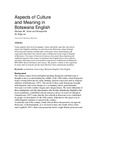| dc.contributor.author | Alimi, M.M. | |
| dc.contributor.author | Bagwasi, M.M. | |
| dc.date.accessioned | 2011-03-07T09:31:38Z | |
| dc.date.available | 2011-03-07T09:31:38Z | |
| dc.date.issued | 2009 | |
| dc.identifier.citation | Alimi, M.M. & Bagwasi, M.M. (2009) Aspects of culture and meaning in Botswana English, Journal of Asian and African Studies, Vol. 44, No.2, pp. 199-214 | en_US |
| dc.identifier.issn | 0021-9096 | |
| dc.identifier.uri | http://hdl.handle.net/10311/728 | |
| dc.description.abstract | Using samples from local newspapers, letters and public speeches, this article argues that English assimilates to and reflects the Botswana culture through borrowing and semantic modification. It discusses those terminologies and
expressions that depict the cultural values of Batswana in the usage of English in Botswana. Two types of borrowed items are discussed: those depicting old
traditional practices that cannot be translated into English (kgosi and mophato)
and those reflecting recent socio-political experiences in Botswana including the HIV/AIDS threat (tebelopele and omang). The people’s culture is also expressed by items such as brigade and the lands that have been semantically modified. | en_US |
| dc.language.iso | en | en_US |
| dc.publisher | Sage Publications http://www.sagepublications.com | en_US |
| dc.subject | Acculturation | en_US |
| dc.subject | Borrowing | en_US |
| dc.subject | Botswana English | en_US |
| dc.subject | New English | en_US |
| dc.subject | Semantic modification | en_US |
| dc.title | Aspects of culture and meaning in Botswana English | en_US |
| dc.type | Published Article | en_US |

